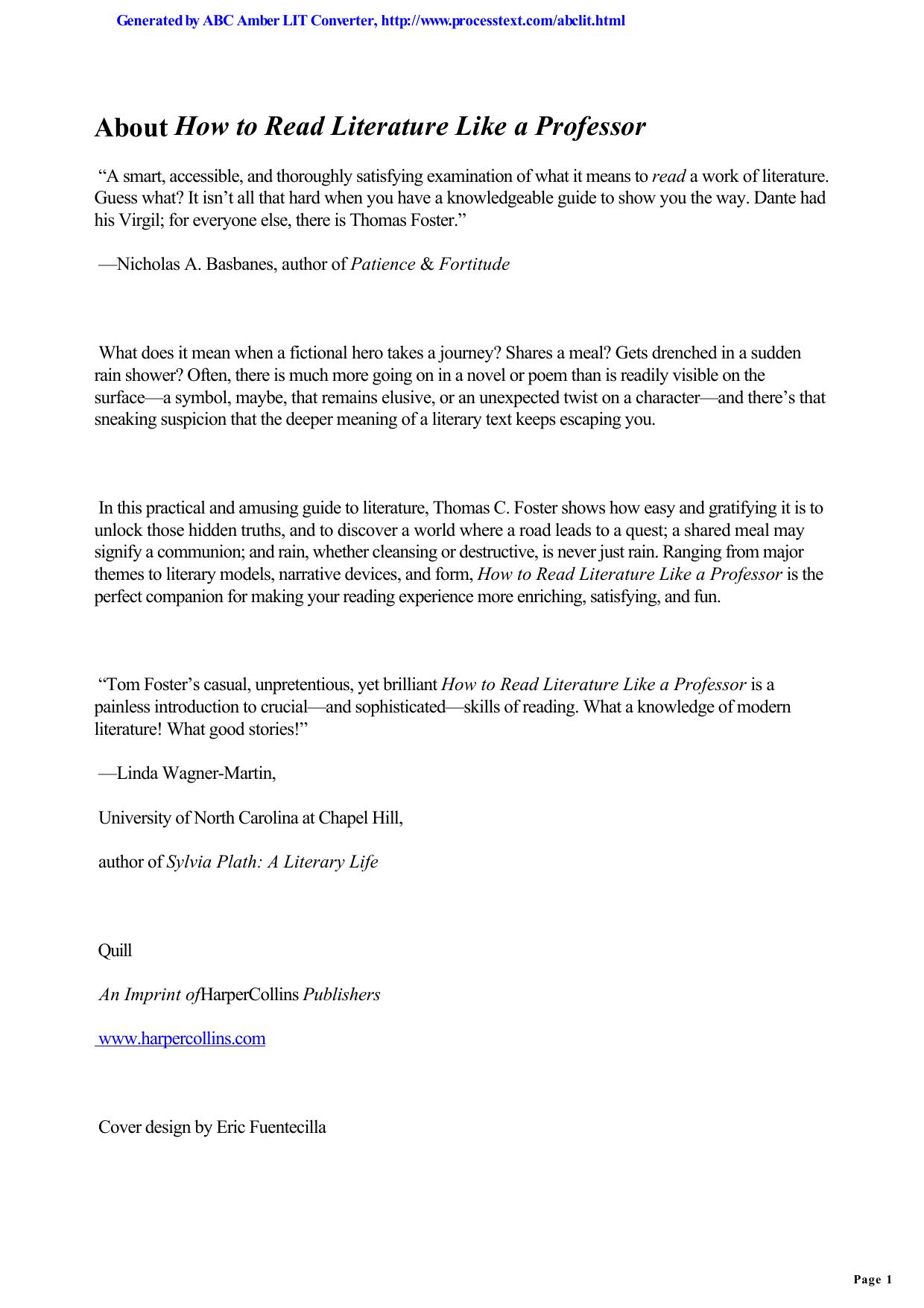How to Read Literature Like a Professor: A Lively and Entertaining Guide to Reading Between the Lines by Thomas C. Foster

Author:Thomas C. Foster
Language: eng
Format: mobi, epub, pdf
Tags: Criticism, Literature, Reference, Literature - History and criticism, General, Books and reading, Literary Criticism, Books & Reading, Semiotics & Theory
ISBN: 9780060009427
Publisher: HarperCollins
Published: 2003-03-15T18:00:50+00:00
If She Comes Up, It’s Baptism
QUICK QUESTION: I’m walking down the road and suddenly I fall into a pond. What happens?
You drown?
Thanks for the vote of confidence.
Or you don’t?
That pretty much covers it. Now what does it mean?
Does it really mean anything either way? I mean, if you drown, you drown. If you get out, maybe all it means is you can swim.
Fair enough. For a character in a novel, though, the case is different. What does it mean if he drowns, or if he doesn’t? Have you ever noticed how often literary characters get wet? Some drown, some merely get drenched, and some bob to the surface. What difference does it make?
First of all, let’s take care of the obvious. You can fall into the water in an instant, from a bridge that gives way, for instance, or you can be pushed, pulled, dragged, tripped, or tipped over. All of which have their own meanings, of course, and can be taken quite literally. Beyond that, drowning or not has profound plot implications, as do the means by which a character does or doesn’t drown.
Consider, just for a moment, that a disconcertingly large number of writers meet their ends in water. Virginia Woolf. Percy Bysshe Shelley. Ann Quin. Theodore Roethke. John Berryman. Hart Crane. Some walked in, some jumped, others swam out and didn’t come back. Shelley’s boat capsized and Frankenstein’s author became a very young widow. Iris Murdoch, who drowns enough characters that it seems like a hobby, herself nearly drowned in the sea fairly late in her career. Young Sam Clemens, years away from being Mark Twain, repeatedly had to be fetched out of the Mississippi. So maybe on some level tossing characters into the river is (a) wish fulfillment, (b) exorcism of primal fear, (c) exploration of the possible, and not just (d) a handy solution to messy plot difficulties.
But back to our soggy character. Is he rescued? Does he swim out? Grab a piece of driftwood? Rise up and walk? Each of those would imply something different on the symbolic level. For instance, rescue might suggest passivity, good fortune, indebtedness. The piece of driftwood raises issues of luck and coincidence, serendipity rather than planning.
Remember the situation that begins Judith Guest’s Ordinary People (1976)? Most likely. If you’re over a certain age, you probably saw the film in a theater (almost everyone did, evidently), and if you’re under a certain age you had it assigned, at least, in high school English.
So you know the deal. Two brothers go out sailing on Lake Michigan, a storm comes up, and one of them drowns. And one doesn’t. Now the story works because it’s the older, stronger son, the swimming star and apple of his mother’s eye, the one who never dies except in family tragedies and war stories, who perishes. The younger one, Conrad, the one who would never survive, survives. And he’s tortured by his success at living, to the point where he tries to kill himself. Why? He can’t be alive.
Download
How to Read Literature Like a Professor: A Lively and Entertaining Guide to Reading Between the Lines by Thomas C. Foster.epub
How to Read Literature Like a Professor: A Lively and Entertaining Guide to Reading Between the Lines by Thomas C. Foster.pdf
This site does not store any files on its server. We only index and link to content provided by other sites. Please contact the content providers to delete copyright contents if any and email us, we'll remove relevant links or contents immediately.
| Booksellers & Bookselling | General |
| History of Books |
4 3 2 1: A Novel by Paul Auster(12283)
The handmaid's tale by Margaret Atwood(7679)
Giovanni's Room by James Baldwin(7191)
Asking the Right Questions: A Guide to Critical Thinking by M. Neil Browne & Stuart M. Keeley(5635)
Big Magic: Creative Living Beyond Fear by Elizabeth Gilbert(5610)
Ego Is the Enemy by Ryan Holiday(5294)
The Body: A Guide for Occupants by Bill Bryson(4974)
On Writing A Memoir of the Craft by Stephen King(4863)
Ken Follett - World without end by Ken Follett(4645)
Adulting by Kelly Williams Brown(4487)
Bluets by Maggie Nelson(4473)
Eat That Frog! by Brian Tracy(4435)
Guilty Pleasures by Laurell K Hamilton(4360)
The Poetry of Pablo Neruda by Pablo Neruda(4039)
Alive: The Story of the Andes Survivors by Piers Paul Read(3968)
White Noise - A Novel by Don DeLillo(3954)
Fingerprints of the Gods by Graham Hancock(3940)
The Book of Joy by Dalai Lama(3899)
The Bookshop by Penelope Fitzgerald(3775)
